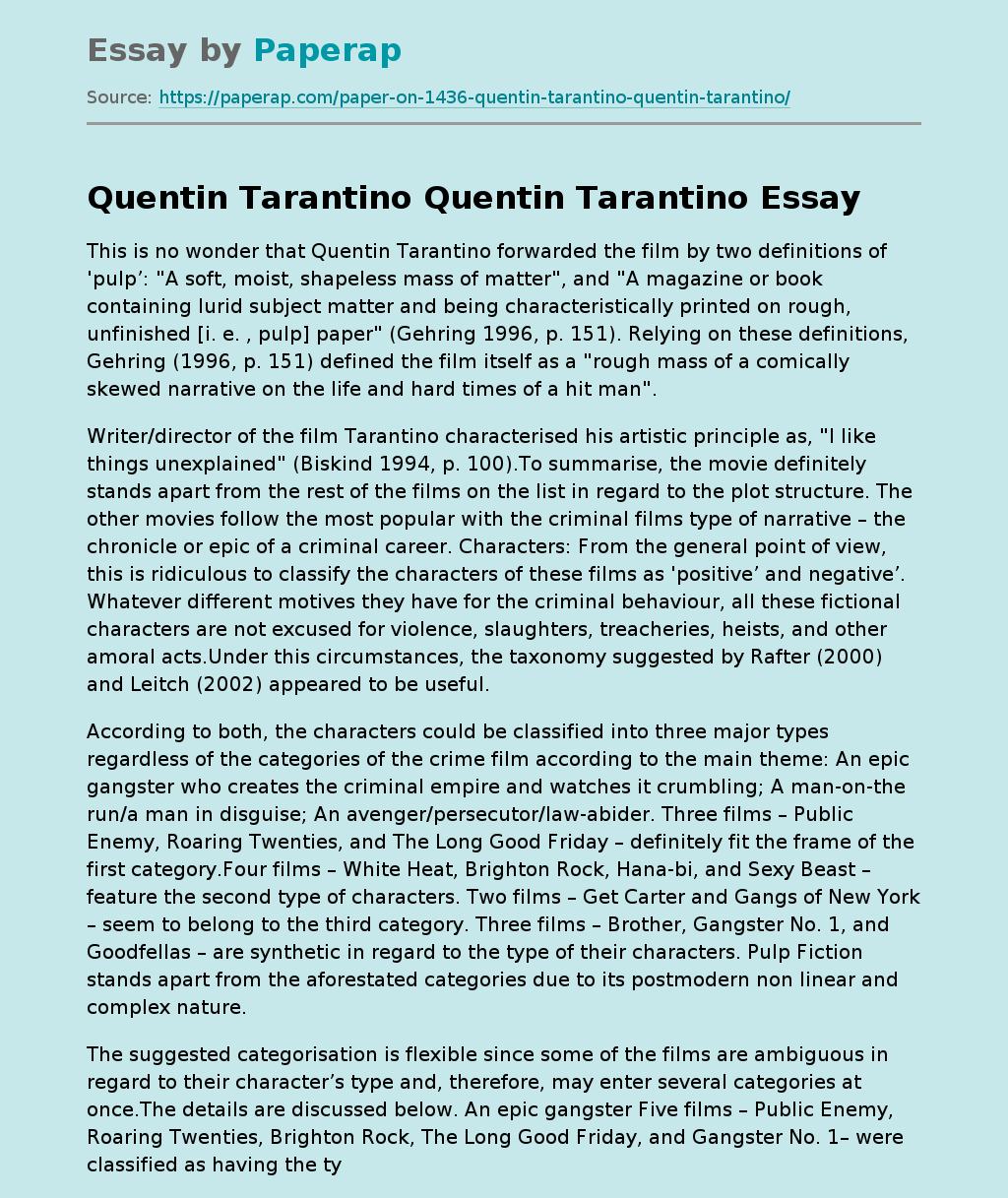Quentin Tarantino
The following sample essay on: “Quentin Tarantino “. This is no wonder that Quentin Tarantino forwarded the film by two definitions of ‘pulp’: “A soft, moist, shapeless mass of matter”, and “A magazine or book containing lurid subject matter and being characteristically printed on rough, unfinished [i. e. , pulp] paper” (Gehring 1996, p. 151). Relying on these definitions, Gehring (1996, p. 151) defined the film itself as a “rough mass of a comically skewed narrative on the life and hard times of a hit man”.
Writer/director of the film Tarantino characterised his artistic principle as, “I like things unexplained” (Biskind 1994, p.
100).To summarise, the movie definitely stands apart from the rest of the films on the list in regard to the plot structure. The other movies follow the most popular with the criminal films type of narrative – the chronicle or epic of a criminal career. Characters: From the general point of view, this is ridiculous to classify the characters of these films as ‘positive’ and negative’.
Whatever different motives they have for the criminal behaviour, all these fictional characters are not excused for violence, slaughters, treacheries, heists, and other amoral acts.Under this circumstances, the taxonomy suggested by Rafter (2000) and Leitch (2002) appeared to be useful.
According to both, the characters could be classified into three major types regardless of the categories of the crime film according to the main theme: An epic gangster who creates the criminal empire and watches it crumbling; A man-on-the run/a man in disguise; An avenger/persecutor/law-abider. Three films – Public Enemy, Roaring Twenties, and The Long Good Friday – definitely fit the frame of the first category.
Four films – White Heat, Brighton Rock, Hana-bi, and Sexy Beast – feature the second type of characters. Two films – Get Carter and Gangs of New York – seem to belong to the third category. Three films – Brother, Gangster No. 1, and Goodfellas – are synthetic in regard to the type of their characters. Pulp Fiction stands apart from the aforestated categories due to its postmodern non linear and complex nature.
The suggested categorisation is flexible since some of the films are ambiguous in regard to their character’s type and, therefore, may enter several categories at once.The details are discussed below. An epic gangster Five films – Public Enemy, Roaring Twenties, Brighton Rock, The Long Good Friday, and Gangster No. 1– were classified as having the type of an epic gangster as a main hero. In regard to the earliest film on the list, Public Enemy, Shadoian (2003, p. 29) once stated that its main character, Tom Powers (James Cagney) is likely to “succumb to a combination of hubris, social fate, and moral reckoning in plots resembling those of classical tragedy”.Within “a tradition of popular tragedy in film” (Shadoian 2003, p. 29), the heroes like Tom Powers possess strong charisma but are “cursed by their nature, their environment, their heritage”, so far as “their desires and goals [are] overwhelmed by an immutable and often unpredictable concatenation of forces”.
Tom Powers’ environment makes him the victim. Tom Powers, the youngest son in the lower middle-class family of a police officer and a housewife, grows up in a small industrial city. He learns his first lessons not at school desk but rather in a brewery, a local honky-tonk place under the guidance of Putty Nose, and on the streets.Starting with petty thefts, Tom is rising gradually on the criminal scale and finally establishes the criminal empire of his own. Tom Powers is abandoned by all social institutes: his family, his class, the society in general. It is made clear that the hero has positive inclinations in regard to his ambitious desires ‘to become somebody’, “to bust out of this deprived, depressing limbo of aimless loafing” (Shadoian 2003, p.
54).But society plied Tom with insufficient knowledge and skills to become somebody else than a gangster.
As Shadoian (2003, p.
50) emphasised, the appeal of Tim’s personality was preconditioned by the fact that his “aspirations are located in his desire and his ability to be a certain way, to exist in a lively manner”. The spectator is permitted no direct access to the overt signs of Tom’s prosperity. What matters, what is gripping, is Tom Powers’s personal vitality in a context of inertia, stolidity, and hesitancy, and it can only have scope outside the boundaries of legitimate activity. (Shadoian 2003, p. 50) Tom knows how to live, and we admire him for that.We respond to his amoral enjoyment of a full array of life’s pleasures. We lose sight of the cost to others his living so high and free exacts. The gangster’s defects become virtues, the surface manifestations of his success obscuring his more important failings.
[…] We are so caught up in Tom’s urge to live that we do not take full advantage of several opportunities to back away from him.
The values he carries are too attractive.
Long after the film has made it clear that he’s a lost cause not worth backing, the shock of his mortality registers. (Shadoian, 2003, pp. 54-55)
Quentin Tarantino. (2017, May 30). Retrieved from https://paperap.com/paper-on-1436-quentin-tarantino-quentin-tarantino/

